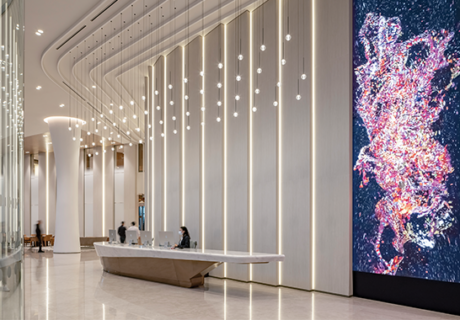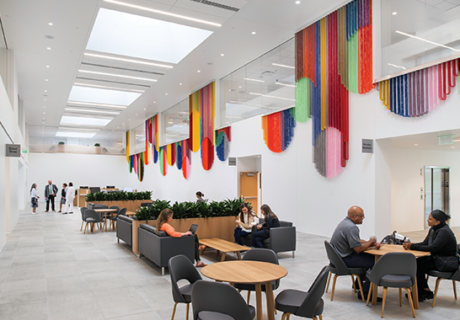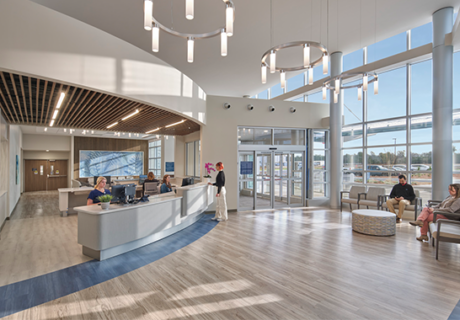2018 Design Showcase Award of Merit: Good Neighbor
Sunshine coast university Hospital (SCUH) opened in September 2016 in Queensland, Australia. At 1.9 million square feet, it’s the country’s largest nonreplacement greenfield project to date. But it wasn’t its size that wowed our jurors; they lauded the project for its regionally appropriate design, expansive outdoor gathering spaces, and connection to community.
Part of a 49-acre integrated health campus, which includes research and training facilities, the building was designed to capture the qualities of the region’s culture, climate, views, and character while creating a patient-centered healing environment. The facility opened with 450 inpatient beds, with plans to expand to 738 by 2021, and includes an emergency department; cancer center; and maternity, rehabilitation, mental health, renal, and interventional and diagnostic services.
Inspired by the area’s modern architecture as well as its warm climate and intense sun, the exterior design includes lightweight cladding and extensive external screens. A network of courtyards can be found throughout the campus, bringing therapeutic vegetation into the heart of the hospital as well as serving as wayfinding references for public circulation.
One of the campus highlights is a semi-enclosed gathering space, the “outdoor room,” that’s shared by the hospital and the neighboring Sunshine Coast Health Institute. The outdoor setting is covered with timber battens and fritted glass. Inside, the main circulation route runs the length of the main courtyard and features a double-height space, creating a Main Street setting that’s lined with retail outlets, cafés, and seating bays, further inviting the community to connect with the clinical environment.
The project was submitted by HDR and Architectus Brisbane. Here, Ronald Hicks, principal and national director of health Australia at HDR, shares his perspective on how some of the jurors’ favorite design elements were achieved.
Healthcare Design: Jurors were impressed by the regionally appropriate architecture and design solutions throughout this project. What was your design process like?
Ronald Hicks: We recognized from the outset that the overall design strategy needed to reflect a focus on context. However, our intent was to go beyond the mere use of appropriate visual language. For example, the setting’s existing fabric, climate, and commanding views guided us to emphasize the use of courtyards and large windows and to then plan the major circulation routes along glazed edges with a direct visual link to the lush green spaces and the expansive blue of the ocean. We also demonstrated our respect and understanding of the local context and architectural vernacular through the scale, materiality, approach to detailing, simplicity, and clarity of concept. These were such major influences on our design that the dominant courtyards and landscape shaped the plan form and became an organizational force behind the structure of the clinical chassis.
One of the goals of this project was to deliver a facility that established the character of the surrounding health precinct. How is that achieved?
Our urban approach to planning and the ensuing master plan established an overall structure for the broader health precinct. The major components were arranged around landscape zones with well-defined linkages and pronounced axes that were, once more, reinforced by landscape features. The outdoor room became a vibrant public space and a civic anchor for several elements. It took a deep understanding of the climatic and contextual issues to ensure that all spaces were optimally orientated and scaled to maximize potential for outdoor activities in the most sound and functional manner. We adopted this approach with the intent of facilitating the broader community’s engagement with the project at several levels—not merely as a provider of clinical services.
Jurors appreciated how your design responded to the local climate in a variety of ways. How did you approach this?
We incorporated a number of passive environmental strategies following careful analysis of building orientation and façade solar exposure. The orientation and degree of enclosure of external landscaped spaces reflect our understanding of the local climate—not just in terms of the sea breezes, but also the more challenging aspects such as the summer tropical storms that are a common late-afternoon occurrence at certain times of the year. The building entrances are well protected, and the outdoor courtyards are protected from the elements while simultaneously exploiting the cooling aspects and filtered sunlight provided by the louvered façades.
How does the design reinforce a sense of belonging to the community?
Throughout the planning of this major tertiary hospital, we focused on integrating urban elements like civic space, streets, and courtyards so that they become intertwined with the clinical elements. The emphasis is not only on major clinical spaces but the “spaces in between.” Recognizing the importance of the journey, we carefully considered all linkages in terms of an urban feel, scale, and relevance of human scale, as well as appropriate functional separation for the project’s different categories of users. The result includes external spaces with a dominant character that’s reflective of the context and climate and to which people can easily relate.
Anne DiNardo is executive editor of Healthcare Design. She can be reached at anne.dinardo@emeraldexpo.com.







